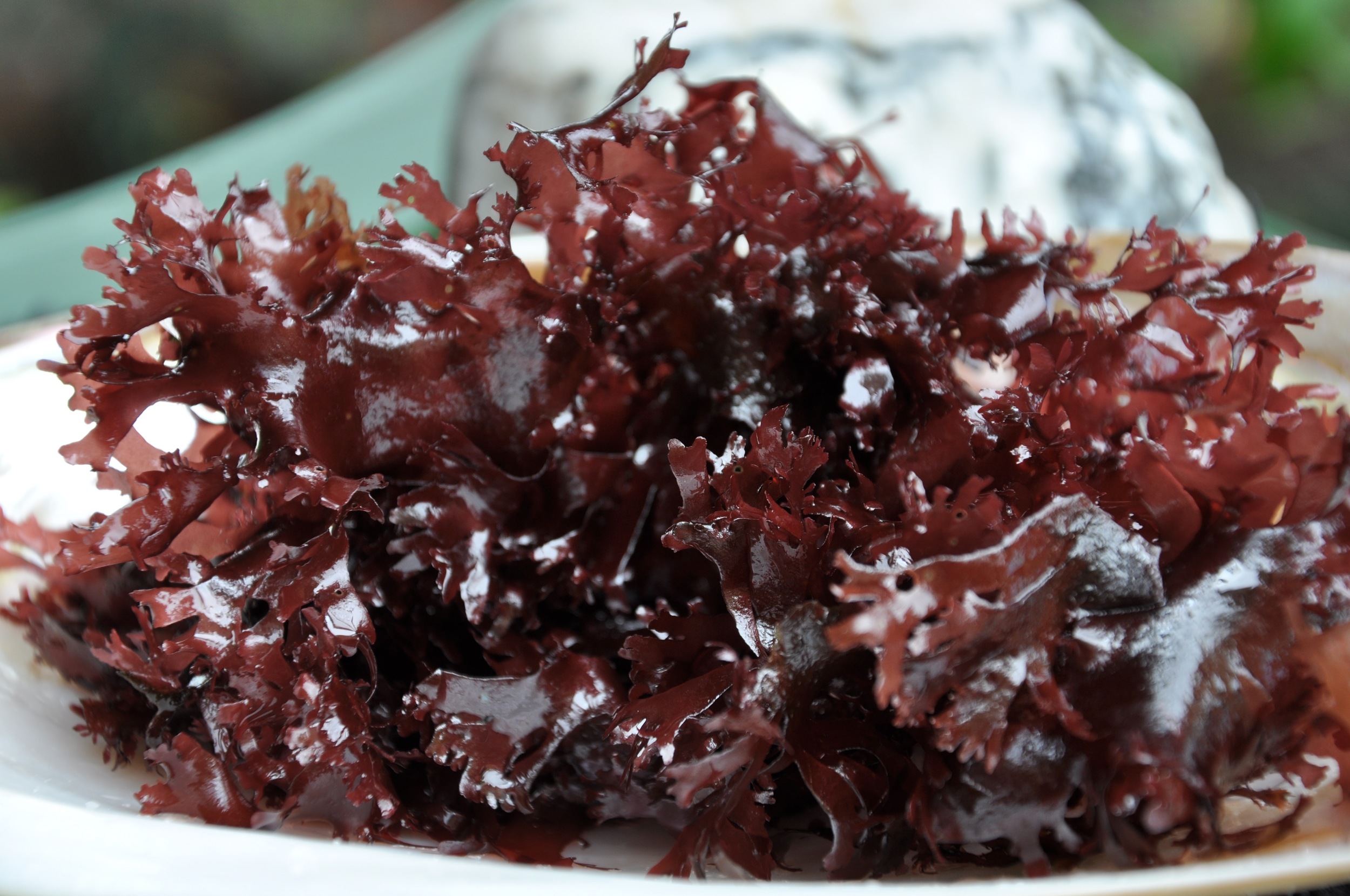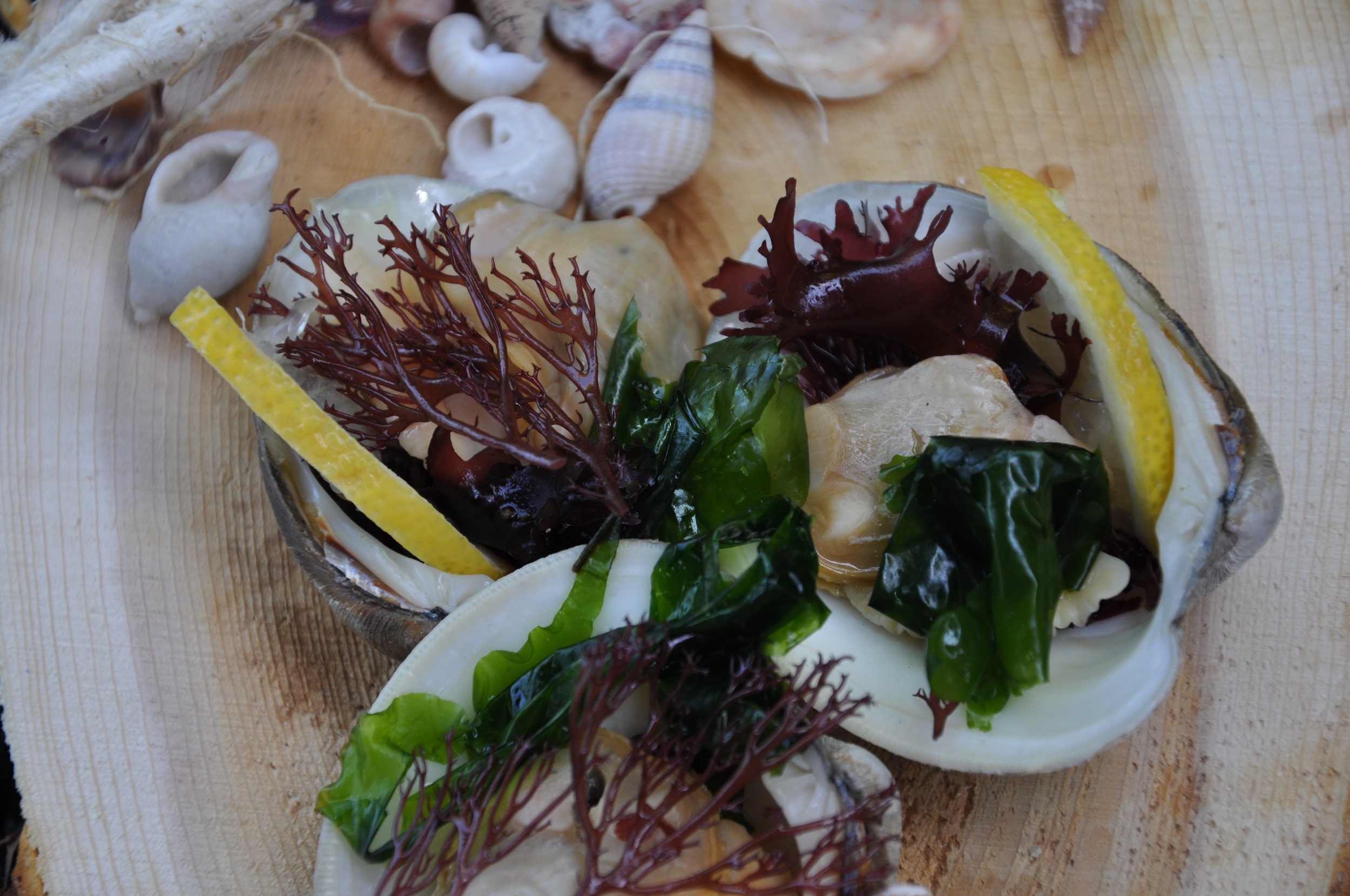
DULSE
A rare find on the West Coast, fresh dulse is now available to chefs on a daily basis. Our dulse is delivered not just fresh and raw, but still alive. We package it in sterilized sea water so it is ready to use.
Dulse is a thicker brownish variety of red seaweed that is known for its 'bacon-like' flavor when fried. It can be used raw, steamed, fried or used to make a flavorful broth. When the dulse is cooked it will lose its reddish-brown color and turn to a deep green. Dulse will become very crisp when fried and served as bar snacks, crumbled over other ingredients or used as structured layers to create a beautiful modern look.
With a deep umami taste, we have used dulse to create broths used in innovative cocktails and as simple additions to traditional drinks such as an Ooh Mommy Bloody Mary.

OGO
Crisp, light and salty, ogo seaweed is often found as a signature ingredient in Hawaiian poke preparations. Ogo is also known as limo in some markets in Hawaii. It has a fluffy texture and a deep reddish-brown color when fresh.
Ogo is wonderful when served raw in salads, in cold broths, with shellfish preparations and with ceviches or sushi. When cooked, ogo turns from a reddish-brown to a deep green color. It can be steamed or used in cold infusions. Pastry chefs should play with the jellifying properties of ogo, as it is one of the seaweeds used to make agar. Besides creating interesting textures in desserts, the fresh ogo will add a unique dimension and enhancement to other flavors.
Ogo has another interesting characteristic in that it turns to a bright orange when immersed in alcohol like gin. Some bartenders have harnessed this vibrant color to add a special look to a flight of shots by adding a bit of seaweed to each glass. It's both beautiful and tasty.

SEA LETTUCE
Green sea lettuce is a delicate variety of seaweed. With a delicate sheet like structure and bright emerald green color, it adds a clean crisp taste and visual aspect to dishes. Sea lettuce can be used to wrap fish, added to salads or soups and can even be used in cocktails.
Currently only available on a limited basis.

SEA GRAPES
Seagrapes are a striking rose-red alga which resembles a cluster of red grapes. Like terrestrial grapes, seagrapes have a thin skin that pops to release a viscous sugary and salty brine. They are a true delicacy of the sea and are great as a garnish to complement sweet or savory flavors, add color, or texture to a variety of dishes.
This is the newest addition to the farm and is currently only available on a limited basis.

FAQS
What can be done with seaweed?
Seaweed is a versatile ingredient. It can be used raw, steamed, marinated, fried crisp or even pickled. We have seen fresh seaweed used in vinaigrette poured over grilled cauliflower steaks, paired with roasted lamb and in amazing bar preparations. Dulse can be fried until crisp and served as a great bar snack or used to make a vegan dashi, sea lettuce can be wrapped around sashimi or infused in gin for a Monterey Bay Martini and ogo can be used just about anywhere.
And by the way, we have been told that the cold pickling process seems to work best...but we are not exactly sure why.
What makes seaweeds special in the kitchen?
What makes seaweed special is the relatively high amount of protein. This protein, along with the amino acid glutamate, and the inherent potassium (the salts inside the seaweed as opposed to the salts coating it) and minerals, is what some chefs refer to as umami. It is what leads to that special fullness and mouth-feel that chefs like to talk about. Some chefs actually say 'sea-mami', but that's up to you.
What makes seaweed interesting when it comes to textures and thickening are the carbohydrates. This is why some chefs use seaweed, agar, carrageenan and alginates when working in molecular gastronomy.
Soaking fresh seaweeds in certain alcohols lends not just flavors but also some great colors. Bartenders can have a lot of fun with this when creating new drinks for the bar menu.
How is the seaweed farmed?
Our seaweed is farmed in flow-through tanks. We only use seawater and sunshine - there are NO additives or chemicals.
How is farming Monterey Bay Seaweeds sustainable?
Monterey Bay Seaweeds are cultivated in land-based tanks and are grown with very few resources, meaning there are no inputs as far as feeds or chemicals. By cultivating seaweeds in these tanks there is no impact on the environment as a result of wild harvest.
Monterey Bay Seaweed is delivered alive to the kitchen. What does that mean and why is it important?
When the seaweed is harvested, it is scooped out of the tank, weighed, then packaged in sterile seawater before being sent off directly to chefs. In fact, if we were to put the seaweed back into the tank, it would do fine and continue growing just as it had before. Another reason this is important is due to the use of sanitizers in commercial kitchens. If kitchen utensils, like tongs, spoons or ladles are not rinsed before removing Monterey Bay Seaweeds from their packets, they will introduce chemical sanitizers to the seawater which will kill the seaweeds. It is important to rinse all utensils before introducing them to the seaweed water. Remember, this seaweed is alive so it is vital to watch out for cross contamination.
What is the difference between fresh Monterey Bay Seaweeds and dried seaweeds?
Our seaweed is alive. This means if we were to put it back into the tanks of nutrient rich sea water it would continue to grow. Dried seaweed is dried....simply put, dead.
Once seaweed is dried, it will only ever rehydrate to about 80%, meaning it will have a heavier texture or mouthfeel. Our fresh, live seaweed still has a fully intact cell structure along with all the nutrients from the original sea water. This means it has an unparalleled crunch, full flavor and amazing texture. Besides, once fresh seaweed is dried, no-one really knows what nutrients are lost. What we can be sure of is that our fresh, raw live seaweeds are ready to be served just as they would fresh out of the ocean.
What is the shelf-life of Monterey Bay Seaweeds once delivered?
Our seaweeds are packed in sterile seawater. If kept under good refrigerated conditions and no cross contamination occurs (remember the sanitizer note from above!) then you can count on a solid week of sustained freshness. If for some reason the seaweeds need to be refreshed, a mixture of 1/2 cup table salt and 1 gallon of fresh water can be used to replace the original water the seaweed came in.
No...just because the seaweed is alive doesn't mean it will continue to grow in the water used for packing. This is sterile sea water and therefore it has no nutrients. Sorry chef, you will have to re-order.
How are Monterey Bay Seaweeds packaged?
Our seaweeds come in sterile seawater and are ready to use. They are fresh, raw and actually still alive.
What is the season for the different types of Monterey Bay Seaweeds?
Ha! This is a trick question as there are no seasons for our seaweeds. They are sustainably farmed in land-based tanks and harvested to order. The seaweeds are available year-round.
How can my restaurant order Monterey Bay Seaweeds?
We currently supply seaweeds directly from the farm to restaurants and chefs nationwide; we do not ship internationally because our seaweeds are shipped live and will not survive delays during customs screening.
If you are a chef looking for our seaweeds outside of these areas, please let us know more about who and where you are. Chick here for our contact form.

WILD HARVEST VS FARMED SEAWEED
Wild Harvest vs. Farmed Seaweed
Seaweeds can be foraged but this must be done with great care. For responsible and sustainable seaweed management, a forager must understand the local ecology and only harvest where there will not be a detrimental lasting impact.
In addition to any environmental impact, chefs must be very careful when sourcing wild seaweeds in order to make sure they are not coming from polluted waters. Chefs should only buy wild seaweed from experienced and responsible foragers. It is also important to buy only wild seaweed that have been harvested by hand, as this has less of an impact on the environment.
All wild seaweed should be carefully washed as well as picked over to make sure that all animals and any grit, sand or rocks are removed.
Wild seaweed was sustainably harvested by hand to start the Monterey Bay Seaweeds farm. This initial seaweed stock was used to kickstart the farming process. Now that there is developed seaweed growth, no more wild seaweed is needed.
Interested in a type of seaweed we don't currently farm?
Calling all chefs! If you have experienced a great tasting seaweed harvested from the wild and are looking to find a sustainable and dependable source, let us know. We might be able to farm your favorite variety in our land-based tank system.